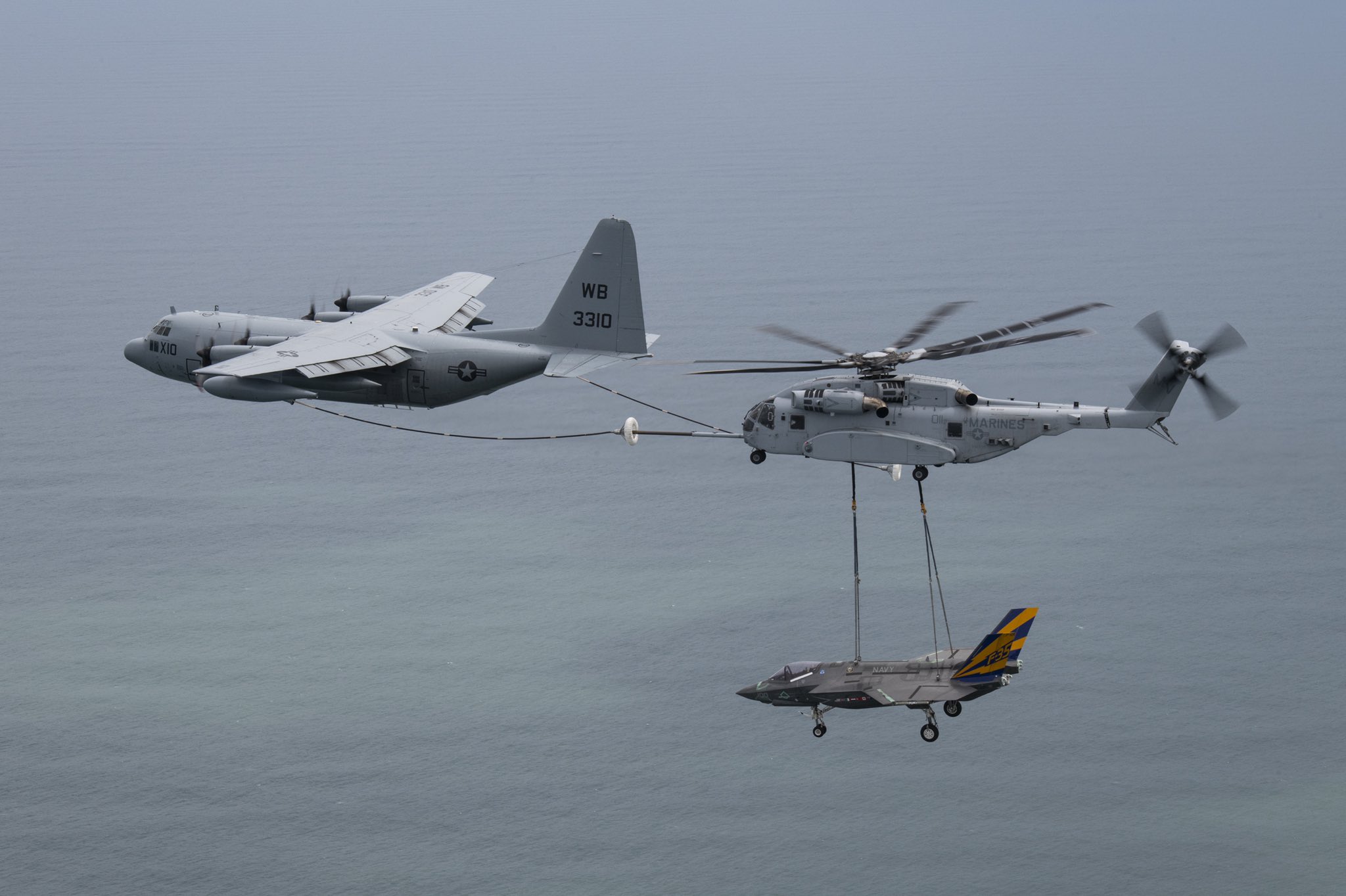The US Marine Corps (USMC) has released stunning imagery of a CH-53K King Stallion, the US military’s most powerful helicopter, getting refueled mid-air while transporting a stripped-down F-35C aircraft.
The extraordinary operation, captured in both images and video, demonstrated the load-carrying capabilities of the CH-53K King Stallion helicopter.
According to the US Marines, “A Marine aviator from Marine Test and Evaluation Squadron 1 (VMX-1) piloted the most powerful helicopter in the Department of Defense that carried the inoperable airframe.”
The operation was conducted to transport the stripped-down aircraft to the Prototype, Manufacturing, and Test (PMT) Department of the Naval Air Warfare Center Aircraft Division (NAWCAD) in Lakehurst, New Jersey.
The F-35C airframe, designated CF-1, was devoid of its mission and propulsion systems, outer wings, or additional equipment. Its journey from Patuxent River to Lakehurst, located in Joint Base McGuire-Dix-Lakehurst, marked a major step in advancing emergency recovery systems testing.

This was not the first instance of a CH-53K King Stallion carrying such a payload. In January 2023, a similar operation was conducted by Marine Operational Test and Evaluation Squadron (VMX), where the heavy-lift helicopter successfully lifted a US Navy F-35 Lightning II airframe.
The Navy said at the time that the primary objective of that operation was to evaluate load capacity and inform future lift capabilities of the CH-53K.
However, what sets this latest operation apart is the inclusion of mid-air refueling, a complex and potentially hazardous maneuver. Combining both tasks underscores the versatility and adaptability of the CH-53K King Stallion in handling multifaceted missions.
The successful execution of the operation provided invaluable insights for both the Marines and the Navy in the King Stallion’s capacity to transport oversized payloads over extended distances.
These abilities are especially important in the changing landscape of expeditionary and distributed operational strategies, particularly given the increased tensions in the Indo-Pacific region involving China.
CH-53K King Stallion: Vital For Marine Corps Missions In The Indo-Pacific
The Marine Corps has long relied on CH-53 helicopters for transporting damaged or inoperable equipment and other large payloads. With the introduction of the CH-53K King Stallion variant, this capability has been further enhanced.
Although the first CH-53K was delivered to the USMC in May 2018, its development faced significant delays.
The Corps declared initial operational capability with the type in 2022. The planned first operational deployment of these helicopters aboard an amphibious assault ship has been pushed back to 2026.
Despite these setbacks, the USMC remains committed to acquiring 200 CH-53Ks in total, according to Naval Air Systems Command (NAVAIR). Sikorsky, the manufacturer, has stated that it can produce up to two units per month at its peak to meet the service’s requirement for a replacement for the CH-53E Super Stallion.
The advanced capabilities of this helicopter are crucial for the service’s future distributed aviation operations. Upgraded engines generating 7,500 pounds of shaft horsepower each, along with rotor blades constructed from enhanced composite materials, ensure optimal performance in high-temperature and high-altitude conditions.
Boasting a maximum payload capacity of 36,000 pounds and powered by three potent GE T408 engines, the CH-53K outperforms its predecessor, the CH-53E Super Stallion, by nearly doubling the external payload it can carry over a 110-mile radius.
This large lifting power makes the King Stallion indispensable for transporting vital equipment and personnel during critical missions, particularly in austere and hostile environments.
The latest development comes at a crucial juncture for the Marine Corps, which has been reevaluating its force structure and strategic focus to counter modern threats.
The helicopter will be instrumental in the Marine Corps Force Design 2030 effort, envisioned by Former Marine Corps Commandant General David H Berger. This strategy involves modernized island-hopping campaigns, with scattered groups of Marines moving from island to island.
The CH-53K’s importance in the Marine Corps’ strategic focus on island-hopping operations, particularly in the Pacific theater against adversaries like China, cannot be overstated.
It aligns with the concept of stand-in troops, which are highly mobile and lethal units operating within the enemy’s “weapons engagement zone.” This strategy aims to counter the Chinese threat, especially in the Western Pacific region.
In combating China’s Anti-Access/Area Denial (A2/AD) bubble, the delivery and introduction of additional heavy-lift CH-53K King Stallions are expected to address logistical challenges and close significant operational gaps.
The helicopter’s enhanced capabilities will undoubtedly strengthen the Marine Corps’ ability to execute its missions effectively in diverse and demanding environments.
- Contact the author at ashishmichel(at)gmail.com
- Follow EurAsian Times on Google News